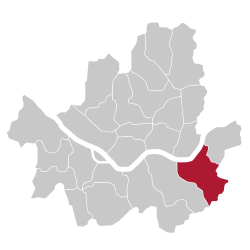Songpa District
|
Songpa 송파구 |
|
|---|---|
| Autonomous District | |
| 송파구 · 松坡區 | |

|
|
 Location of Songpa-gu in Seoul |
|
| Country | South Korea |
| Region | Sudogwon |
| Special City | Seoul |
| Administrative dong | 28 |
| Government | |
| • Mayor | Park Chun-hui (박춘희) |
| Area | |
| • Total | 33.89 km2 (13.09 sq mi) |
| Population (2010) | |
| • Total | 646,970 |
| • Density | 19,000/km2 (49,000/sq mi) |
| Time zone | Korea Standard Time (UTC+9) |
| Postal code | 05500 ~ 05999 |
| Area code(s) | +82-2-400~ |
| Website | Songpa-gu official website |
Songpa-gu is a district of Seoul, South Korea. Songpa is located at the southeastern part of Seoul, the capital of South Korea. Songpa is also the largest population district with 647,000 residents, in Seoul. This had been called as Wirye, when it was the first capital of Baekje. Songpa is generally referred to as a part of Greater Gangnam Area along with Gangnam District and Seocho District.
Songpa was at the center of 1988 Seoul Olympics, and most of the sporting facilities associated with that event are located within the district.
In 2009, Songpa District won the Livcom Awards of UNEP for the most liveable city.
A pine tree, the tree of Songpa, represents vitality and prosperity. Five ovals symbolized pride in hosting the 1988 Seoul Olympics.
It symbolizes the monk of the Songpa mask drama, an intangible cultural property of Songpa District.
Songpa, a World-class city of culture
City with the highest culture index in Korea
The mayor of this district is Kim Young-soon (Hangul:김영순), who has been the only female mayor of the twenty-five mayors in Seoul since her election in July 2006.
Neolithic people lived in the area along the Han River because of the existence of abundant water.
An ancient nation, Gojoseon, was established and more people moved to the region.
In 18 BC, the kingdom of Baekje founded its capital city, Wiryeseong (위례성), which is believed to be inside modern-day Songpa District. Baekje subsequently developed from a member state of the Mahan confederacy into one of the Three Kingdoms of Korea. There are several city wall remains in the Seoul area dating from this time. Among them, Pungnap Toseong (풍납토성), an earthen wall in the southeastern part of modern-day Seoul, (in Pungnap-dong, just near Jamsil-dong area) is widely believed to be the main Wiryeseong site. Yet another earthen wall, Mongchon Toseong (몽촌토성), located nearby, is also dated from the early Baekje era.
...
Wikipedia
